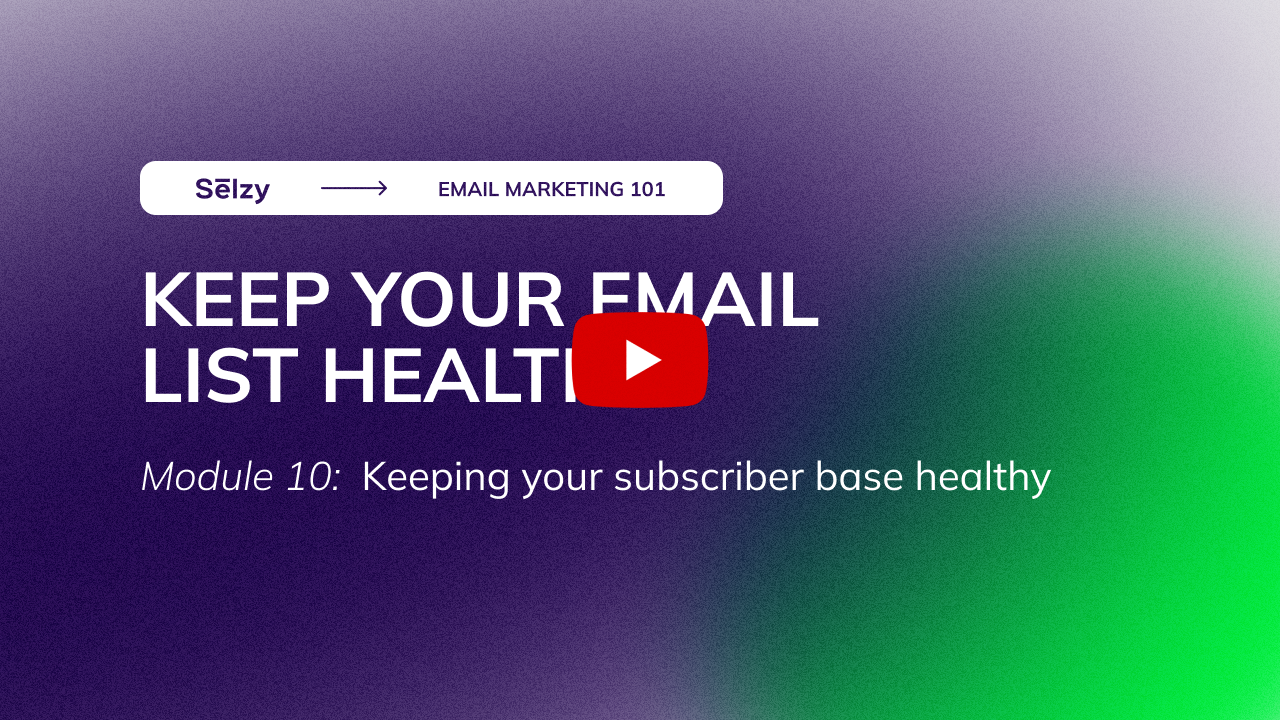How to Prevent Low-Quality Subscribers From Getting on Your List
This is a transcript of lesson 23 of Email Marketing 101 Course by Selzy.

Welcome back to Selzy’s course on email marketing!
In module 9, we explained how to build a successful email marketing strategy.
In this final module, we’ll zoom in on how to keep your mailing list in good shape and get the most out of your efforts..
In lesson 1, we’ll talk about preventive measures. That is, you’ll learn how to prevent low-quality leads from getting on your mailing list.
So, let’s get started!
In the previous lessons, we’ve already talked about mailing list hygiene, what it is, and why it is crucial to maintain it.
But what exactly do you need to do to keep your email list nice and clean?
Well, basically, there are only two methods. These are cleaning your list regularly — and preventing low-quality leads from getting there in the first place.
Now, let’s start with the former because prevention should always be a priority.
How do you prevent low-quality leads from infiltrating your mailing list
Well, here are the three main things that can help you do that:
The first — and most crucial one — is using double opt-in to get explicit consent from new subscribers.
The next one is segmenting your list, which is a proven way to send out more targeted content and reduce unsubscribes.
And the third one is offering a clear “exit sign,” aka “unsubscribe button,” for those not interested in getting emails from you anymore.
Now, let’s talk about each of these three aspects in more detail.
Let’s start with double opt-in
Double opt-in is a sign-up process that includes not one but two steps. The first step takes place when a user enters their email address and hits the “Subscribe” button. In the second step, they receive an email with a link they need to follow to confirm their subscription.
Here’s what this email typically looks like.

This visual is only available in a video lesson
You can also CUSTOMIZE your confirmation email to make it look any way you like — for example, make it less formal and more fun. Like this.

This visual is only available in a video lesson
Now, single opt-in just includes one step, not 2. That means addresses are added to your list without any additional confirmation — and that means you have no guarantee that those addresses are valid and actually belong to the people who provided them. Besides, single opt-in doesn’t give you an opportunity to test the user’s motivation like double opt-in does.
That’s why we recommend double opt-in as the best practice to keep low-quality subscribers off your list.
Don’t worry, adding this extra step won’t scare off your engaged leads. Instead, it will weed out those who are not really interested, thus letting only high-quality subscribers into your list.
So, if you’re still not using double opt-in, check out our step-by-step guide and learn how to set it up — it literally takes a couple of minutes in Selzy!. You can find the link right under this video.
Now that we’ve got this covered let’s move on to the second thing that can help you maintain the high quality of your mailing list.
And that is list segmentation
Essentially, list segmentation is the process of dividing a subscribers list into several groups, aka segments, based on certain characteristics that people in each group have in common.
Also, it is an effective email marketing tactic that is very common due to the impressive results it can deliver. Just take a look at this statistics:
- Segmented and targeted emails generate 58% of all email revenue.
- Marketers report a 760% revenue growth due to segmentation.
- Moreover, 74% of online customers claim they are frustrated when they receive content that is completely unrelated to their interests.
But how exactly does segmentation help? Well, here’s the magic that it can do.
Segmentation helps you send more personalized content
Today, people expect personalized content that caters to their needs. And list segmentation allows you to give them just that. Using it, you can create as many groups as you need, and each one will get highly personalized emails targeted specifically at them.
Let’s say, you sell online courses. Currently, you are launching one-on-one mentoring sessions, and you need to break the news to your subscribers. Here’s how you can do it.
You can simply send emails to your entire list. In that case, they would go like this.

This visual is only available in a video lesson
But you can also send this offer to a specific segment — for example, to those who have already taken your flagship course and rated it highly.

This visual is only available in a video lesson
Now, what do you think — which email will convert better? Obviously, it’s the second one: these people feel special as they got an exclusive discount.
Segmentation helps you optimize the frequency of your emails
You see, in a perfect world, all subscribers are equally engaged. But in reality, it is more likely you have some fans who read all your emails, and you also have subscribers who are less invested. Segmentation enables you to send emails to each group with just the right frequency. And that typically leads to fewer unsubscribes — and higher engagement rates.

This visual is only available in a video lesson
List segmentation is an effective way to push your audience down the funnel
As we know, the ultimate goal of email marketing is to increase sales and drive revenue. To that end, you can use segmentation to divide your subscribers into groups based on the stage of the customer journey they’re at. This practice will enable you to send targeted content tailored to each stage.
For example, if someone has just joined your list, trying to sell them something right away would not be a great idea because you’re barely acquainted yet. Segmentation allows you to isolate these new customers in a separate group and warm them up first. When they become more familiar with who you are and what you can offer, they’ll be more likely to consider making a purchase.

This visual is only available in a video lesson
So, you see, list segmentation is a great tactic that helps boost engagement and reduce unsubscribes, which is very healthy for your mailing list.
How exactly do you segment your list
Well, here are a few typical approaches:
For example, you can segment by demographics.
Like, by gender or age. This practice is particularly common in ecommerce, where sending out product offers based on these characteristics is crucial.
Then, you can segment based on the level of engagement.
As mentioned earlier, not all subscribers are equally invested in your content. So, it makes sense to send different content with a different frequency depending on how engaged a particular segment is.
Then, you can also segment by location.
Sometimes, you would need to send out location-based campaigns — for example, when you need to inform about a specific on-site event such as a sale. That’s when this approach comes in very handy.

This visual is only available in a video lesson
Of course, segmentation is not limited to these 3 ways I’ve mentioned above. Your segmentation criteria should depend on your goals, mailing list volume, business type, and other specifics.
Anyway, the one thing you shouldn’t do is segment your list just for the sake of it, without any particular goal or strategy in mind.
Feeling like you’re ready to segment your list? Check our guide to learn how to do it step-by-step in Selzy. As always, you can find the link right under this video.
Now, let’s move on to the third — and final — aspect of keeping your email list in shape, which is the “unsubscribe button”.
Unsubscribe button
We’ve already discussed the unsubscribe button in detail in module 5. So, let’s just briefly revise the key points here.
A clearly visible unsubscribe button is a natural way of keeping your list clean: those who really wish to stop receiving your emails will use it as a way out of your list. So, always remember to include the unsubscribe button in ALL of your emails — and be sure to make it really easy to find.

This visual is only available in a video lesson
Do not miss an opportunity to get some useful insights by adding a quick survey to your unsubscription page.
Here’s what such a survey might look like, for example:

This visual is only available in a video lesson
Adding this survey will enable you to analyze information, draw conclusions, and come up with ideas about what you can do to prevent further unsubscribes.
Wrap up
And that’s it for this lesson. Now you know the exact steps to ensure that low-quality subscribers — that is, those who are not actually interested in your content — stay away from your mailing list.
But unfortunately, no preventive measure is a 100% guarantee. That means people who don’t really care to interact with your brand will still occasionally pop up on your list. Besides, your existing mailing list might need tidying up in case you haven’t been taking proper care of it lately.
And that leads us straight to our next (and final) lesson. There, we’ll talk about how to clean and reactivate your email database to polish it up and make sure it brings you maximum profit!
Stay tuned!
This is a transcript of lesson 23 of Email Marketing 101 Course by Selzy.